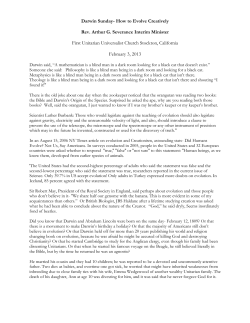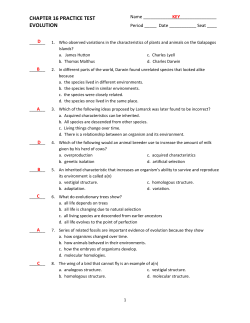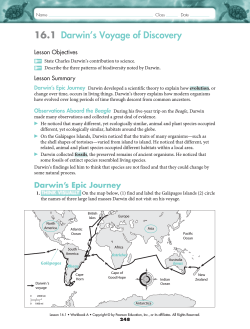
Document 435734
Ft-r III E vc) u -r. c• '7 Coixavvlim 45.1V ID EVCDELVTIC) Isi In the mid-nineteenth century, Charles Darwin's studies led to his hypothesis on evolution. Darwin was a student of biology and geology. His observations of the lifeforms on the Galapagos Islands, including their biogeography, influenced the formation of his hypothesis. Cuvier and Lamarck, contemporaries of Darwin, expressed ideas about evolution that differed from Darwin's. Cuvier, the founder of the science of paleontology, proposed the hypothesis of catastrophism. Lamarck correctly recognized the process of descent with modification among organisms in a population, but he explained the mechanism for that process incorrectly as the inheritance of acquired characteristics. Darwin's view of evolution, in stark contrast to the pre-Darwinian outlook, supported the common descent of organisms. During this process, members of a species evolve adaptations through natural selection. Inherited variations in the members of a population establish the raw material for these adaptations. Through potential overpopulation and the inevitable competition among population members, certain organisms are more likely to survive and reproduce. (These organisms exhibit fitness.) Over generations, this process results in adaptation of the population to the environment. This change in the population over time is called evolution. Numerous lines of evidence currently support Darwin' s theory of common descent and evolution through natural selection. Evidence includes studies from fossils, biogeography, comparative anatomy, and comparative biochemistry. Study the text section by section as you answer the questions that follow. 11415,11.1111,11.11811141,111,PegirkJ ir • Evolution has two aspects: descent from a common ancestor and adaptation to the environment. • In the eighteenth century, scientists became especially interested in classifying and understanding the relationships between the many forms of present and past life. • Gradually in the eighteenth century, scientists began to accept the view that the Earth is very old and that lifeforms evolve or change over time. 1. Before each of the following statements, write pre for the pre-Darwinian or post for the post-Darwinian view of evolution: a. Adaptation to the environment occurs through the work of a creator. b. Hypotheses are tested through observation and experimentation. c. Species are related by common descent. d. The Earth is relatively young, with its age measurable in thousands of years. 140 2. Indicate whether these statements, related to the principles of mid-eighteenth-century taxonomy, are true (T) or false (F). a. A binomial system of nomenclature can be used to classify organisms. b. Different organisms can be arranged according to increasing order of complexity. c. Each species has an ideal structure and function fixed in the sequential ladder of life. d. Gradations occur naturally between species. 3. Label each of the following as reflecting the thinking of these scientists: C—Cuvier L—Lamarck a. b. c. d. A new stratum or mix of fossils in a region signals that a local catastrophe occurred. Members of a population change over time through the inheritance of acquired characteristics. The structure of an animal can be deduced by studying its fossil bones. The increasing complexity of organisms through evolutionary descent is the result of a natural force. 917.1F2 4111151‘ RVV I IN S 1 T 1-i E Mr C> FirVC) L. i..j -1- I 0 ri ( 17* P. 285 - 2 • Charles Darwin's trip around the Southern Hemisphere aboard the HMS Beagle provided him with evidence that the Earth is very old and that evolution does occur. 4. Indicate whether these statements are true (T) or false (F). a. Darwin had no suitable background to be the naturalist on board the HMS Beagle. b. Darwin had taken various science courses and had worked with people who were experts in their fields. c. The HMS Beagle took a trip to South America and then returned. d. The HMS Beagle went around the world in the Southern Hemisphere. Occurrence of Descent (pp. 285-287) 5. Fossils: Darwin noticed a close a. between modern forms and extinct species known only through fossils. He began to think that these fossil forms might be 13. to modern species. If so, the implication is that new species appear on Earth as a result of biological change. Biogeography: Darwin noticed that whenever the environment changed, the types of species C. . He also observed that similar environments have different but d. adapted species. This indicates that species are suited to the environment. Finches: Darwin speculated that a mainland finch was the e. ancestor for all the different species of finches on the Galapagos Islands. This shows that speciation occurs. Conclusion: Based on his observations, Darwin came to accept the idea of f- ; that is, life- forms change over time. 1Slatural Selection and Adaptation (pp. 288-29 1) • Both Darwin and Alfred Wallace proposed natural selection as a mechanism by which adaptation to the environment occurs. This mechanism is consistent with our present-day knowledge of genetics. 6. What is the proper sequence for these statements describing Darwin's theory of natural selection? a. The result of natural selection is a population adapted to its local environment. b. Many more individuals are produced each generation than the environment can support. c. An increasing portion of individuals in succeeding generations have the adaptive characteristics. d. The members of a population have heritable variations. e. Some individuals have adaptive characteristics that enable them to survive and reproduce better than other individuals. 141 7. In each of the following pairs of situations, place a check beside the members that are better adapted: a. In a forest, certain ground plants (1) are able to grow in the shade. (2) require full sunlight. b. In the depths of the ocean, certain fishes (1) need to eat only infrequently. (2) must eat continuously. c. In a mountain village, some inhabitants (1) get dizzy when the oxygen level falls below normal. (2) do not get dizzy when the oxygen level falls below normal. The fossil record, biogeography, comparative anatomy, and comparative biochemistry support a hypothesis of common descent. In questions 8-11, match the statements to the type of evidence supporting evolution. a. The succession of life-forms is revealed through preserved remnants. b. Related organisms share homologous structures. c. Closely related organisms have high correlations in DNA base sequences. d. Organisms arise and disperse from their place of origin. e. Classification includes at least seven categories. 8. Fossil record 9. Biogeography Comparative anatomy 10. 11. Comparative biochemistry 142
© Copyright 2025





















